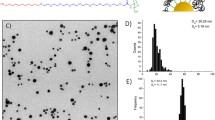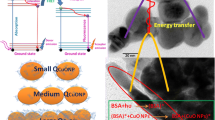Abstract
The ability of nanoparticles to influence protein folding and aggregation is interesting, not only because of the potential beneficial applications, but also the potential risks to human health and the environment. The interactions of concanavalin A (Con A) with zinc oxide nanoparticles (ZnO-NPs) were investigated by using fluorescence, fourier transform infrared spectroscopy, circular dichroism (CD) and dynamic light scattering techniques. ANS fluorescence and CD spectroscopy authenticated the formation of molten globule state of Con A after its incubation with ZnO-NPs for 36 h. Further incubation of 48 h resulted in the aggregation of unadsorbed Con A, proved by decrease in ANS fluorescence while an increase in thioflavin T fluorescence, characteristic of an aggregates. Moreover, Fourier transform-infrared spectroscopy confirmed the aggregation of unadsorbed Con A. The aggregated products were negligible genotoxic as analyzed by pUC19 plasmid degradation and comet assay. It is clear that ZnO-NPs morphology affect unadsorbed proteins structure. A better understanding of these differences will be essential to engineer fully functional nanobioconjugates and NPs which do not damage the proteins present in the biological system.












Similar content being viewed by others
References
Abdelhalim MAK (2011) Gold nanoparticles administration induces disarray of heart muscle, hemorrhagic, chronic inflammatory cells infiltrated by small lymphocytes, cytoplasmic vacuolization and congested and dilated blood vessels. Lipids Health Dis 10:233
Ahmad E, Naeem A, Javed S, Yadav S, Khan RH (2007) The minimal structural requirement of concanavalin A that retains its functional aspects. J Biochem 142:307–315
Arrondo JL, Young NM, Mantsch HH (1988) The solution structure of concanavalin A probed by FTIR spectroscopy. Biochim Biophys Acta 952:261–268
Aubin-Tam ME, Hamad-Schifferli K (2005) Gold nanoparticle–cytochrome C complexes: the effect of nanoparticle ligand charge on protein structure. Langmuir 21:12080–12084
Billsten P, Freskgård PO, Carlsson U, Jonsson BH, Elwing H (1997) Adsorption to silica nanoparticles of human carbonic anhydrase II and truncated forms induce a molten-globule-like structure. FEBS Lett 402:67–72
Boland S, Guadagnini R, Baeza-Squiban A, Hussain S, Marano F (2011) Nanoparticles used in medical applications for the lung: hopes for nanomedicine and fears for nanotoxicity. J Phys Conf Ser. doi:10.1088/1742-6596/304/1/012031
Chah S, Hammond MR, Zare RN (2005) Gold nanoparticles as a colorimetric sensor for protein conformational changes. Chem Biol 12:323–328
Chatterjee T, Chakraborti S, Joshi P, Singh SP, Gupta V, Chakrabarti P (2010) The effect of zinc oxide nanoparticles on the structure of the periplasmic domain of the Vibrio cholerae ToxR protein. FEBS J 277:4184–4194
Chen M, von Mikecz A (2005) Formation of nucleoplasmic protein aggregates impairs nuclear function in response to SiO2 nanoparticles. Exp Cell Res 305:51–62
Chiti F, Webstar P, Taddei N, Clark N, Stefani M, Ramponi G, Dobson CM (1999) Designing conditions for in vitro formation of amyloid protofilaments and fibrils. Proc Natl Acad Sci USA 96:3590–3594
Chiti F, Stefani M, Taddei N, Ramponi G, Dobson CM (2003) Rationalization of the effects of mutations on peptide and protein aggregation rates. Nature 424:805–808
Colvin VL, Kulinowski KM (2007) Nanoparticles as catalysts for protein fibrillation. Proc Natl Acad Sci 104:8679–8680
Cullity BD (1978) Elements of X-ray diffraction. Addison-Wesley, Reading
Das S, Bellare JR, Banerjee R (2012) Protein based nanoparticles as platforms for aspirin delivery for ophthalmologic applications. Colloids Surf B Biointerfaces. doi:10.1016/j.colsurfb.2011.12.033
Deng ZJ, Liang M, Monteiro M, Toth I, Minchin RF (2011) Nanoparticle-induced unfolding of fibrinogen promotes Mac-1 receptor activation and inflammation. Nat Nanotechnol 6:39–44
Fei L, Perrett S (2009) Effect of nanoparticles on protein folding and fibrillogenesis. Int J Mol Sci 10:646–655
Ge C, Du J, Zhao L, Wang L, Liu Y, Li D, Yang Y, Zhou R, Zhao Y, Chai Z, Chen C (2011) Binding of blood proteins to carbon nanotubes reduces cytotoxicity. Proc Natl Acad Sci USA 108:16968–16973
George S, Pokhrel S, Xia T, Gilbert B, Ji Z, Schowalter M, Rosenauer A, Damoiseaux R, Bradley KA, Madler L, Nel AE (2010) Use of a rapid cytotoxicity screening approach to engineer a safer zinc oxide nanoparticles through iron doping. ACS Nano 4:15–29
Haris PI, Severcan F (1999) FTIR spectroscopic characterization of protein structure in aqueous and non-aqueous media. J Mol Catalysis B Enzymatic 7:207–221
Hudson SA, Ecroyd H, Kee TW, Carver JA (2009) The thioflavin T fluorescence assay for amyloid fibril detection can be biased by the presence of exogenous compounds. FEBS J 276:5960–5972
Ipe B, Shukla A, Lu H, Zou B, Rehage H, Niemeyer C (2006) Dynamic light-scattering analysis of the electrostatic interaction of hexahistidine-tagged cytochrome P450 enzyme with semiconductor quantum dots. Chem Phys Chem 7:1112–1118
Jans H, Huo Q (2012) Gold nanoparticle-enabled biological and chemical detection and analysis. Chem Soc Rev. doi:10.1039/C1CS15280G
Jokerst JV, Lobovkina T, Zare RN, Gambhir SS (2011) Nanoparticle PEGylation for imaging and therapy. Nanomedicine (Lond) 6:715–728
Khan RH, Naeem A, Baig MA (2005) Spectroscopic studies on the protective effect of a specific sugar on concanavalin A at acidic, neutral and alkaline pH. Cell Mol Biol Lett 10:61–72
Khan TA, Husain Q, Naeem A (2010) A novel and inexpensive procedure for the purification of concanavalin A from jack bean (Canavalia ensiformis) extract. Eur J App Sci 2:70–76
Khan TA, Amani S, Naeem A (2012) Glycation promotes the formation of genotoxic aggregates in glucose oxidase. Amino Acids 43:1311–1322
Kim J, Park S, Lee JE, Jin SM, Lee JH, Lee IS, Yang I, Kim JS, Kim SK, Cho MH, Hyeon T (2006) Designed fabrication of multifunctional magnetic gold nanoshells and their application to magnetic resonance imaging and photothermal therapy. Angew Chem Int Ed 45:7754–7758
Kogan MJ, Bastus NG, Amigo R, Grillo-Bosch D, Araya E, Turiel A, Labarta A, Giralt E, Puntes VF (2006) Nanoparticle-mediated local and remote manipulation of protein aggregation. Nano Lett 6:110–115
Lamba J, Paul S, Hasija V, Aggarwal R, Chaudhuri TK (2009) Monitoring protein folding and unfolding pathways through surface hydrophobicity changes using fluorescence and circular dichroism spectroscopy. Biochemistry (mosc) 74:393–398
LeVine H (1999) Quantification of beta-sheet amyloid fibril structures with thioflavin T. Methods Enzymol 309:274–284
Li Q, Zeng L, Wang J, Tang D, Liu B, Chen G, Wei M (2011) Magnetic mesoporous organic–inorganic NiCo2O4 hybrid nanomaterials for electrochemical immunosensors. ACS Appl Mater Interfaces 3:1366–1373
Lundqvist M, Sethson I, Jonsson BH (2004) Protein adsorption onto silica nanoparticles: conformational changes depend on the particles’ curvature and the protein stability. Langmuir 20:10639–10647
Lundqvist M, Stigler J, Elia G, Lynch I, Cedervall T, Dawson KA (2008) Nanoparticle size and surface properties determine the protein corona with possible implications for biological impacts. Proc Natl Acad Sci USA 105:14265–14270
Lynch I, Dawson KA (2008) Protein-nanoparticle interactions. Nanotoday 3:40–47
Matulis D, Baumann CG, Bloomfield UA, Lovrien UA (1999) 1-Anilino-8-napthelene sulfonate as a protein conformational tightening agent. Biopolymers 49:451–458
Muga A, Arrondo JLR, Bellon T, Sancho J, Bernabeu C (1993) Structural and functional studies on the interaction of sodium dodecyl sulfate with β-galactosidase. Arch Biochem Biophys 300:451–457
Naeem A, Khan A, Khan RH (2005) Partially folded intermediate state of concanavalin A retains its carbohydrate specificity. Biochem Biophys Res Commun 331:1284–1294
Naeem A, Khan TA, Muzaffar M, Ahmad S, Saleemuddin M (2011) A partially folded state of ovalbumin at low pH tends to aggregate. Cell Biochem Biophys 59:29–38
Nandhakumar S, Parasuraman S, Shanmugam MM, Rao KR, Chand P, Bhat BV (2011) Evaluation of DNA damage using single-cell gel electrophoresis (comet assay). J Pharmacol Pharmacother 2:107–111
Pace CN, Vajdos F, Fee L, Grimsley G, Gray T (1995) How to measure and predict the molar absorption coefficient of a protein. Protein Sci 4:2411–2423
Pelley R, Horowitz P (1976) Fluorimetric studies of tryptophyl exposure in concanavalin A. Biochim Biophys Acta 427:359–365
Richter L, Charwat V, Jungreuthmayer C, Bellutti F, Brueckl H, Ertl P (2011) Monitoring cellular stress responses to nanoparticles using a lab-on-a-chip. Lab Chip 11:2551–2560
Rochet JC, Lansbury PT Jr (2000) Amyloid fibrillogenesis: themes and variations. Curr Opin Struct Biol 10:60–68
San BH, Moh SH, Kim KK (2012) The effect of protein shells on the antioxidant activity of protein-encapsulated platinum nanoparticles. J Mat Chem 22:1774–1780
Semisotnov GV, Rodionava NA, Razgulyaev OI, Uversky VN, Gripas A, Gilmanshin RI (1991) Study of the molten globule intermediate state in protein folding by a hydrophobic fluorescent probe. Biopolymers 31:119–128
Shang W, Nuffer JH, Muniz-Papandrea VA, Colon W, Siegel RW, Dordick JS (2009) Cytochrome C on silica nanoparticles: influence of nanoparticle size on protein structure, stability, and activity. Small 5:470–476
Stryer L (1968) Fluorescence spectroscopy of proteins. Science 162:526–533
Vertegel AA, Siegel RW, Dordick JS (2004) Silica nanoparticle size influences the structure and enzymatic activity of adsorbed lysozyme. Langmuir 20:6800–6807
Wang B, Feng WY, Wang M, Wang TC, Gu YQ, Zhu MT, Ouyang H, Shi JW, Zhang F, Zhao YL, Chai ZF, Wang HF, Wang J (2008) Acute toxicological impact of nano- and submicro-scaled zinc oxide powder on healthy adult mice. J Nanopart Res 10:263–276
Yan L, Zhao F, Li SJ, Hu ZB, Zhao YL (2011) Low-toxic and safe nanomaterials by surface-chemical design, carbon nanotubes, fullerenes, metallofullerenes and graphenes. Nanoscale 3:362–382
Zhang D, Neumann O, Wang H, Yuwono VM, Barhoumi A, Perham M, Hartgerink JD, Wittung-Stafshede P, Halas NJ (2009) Gold nanoparticles can induce the formation of protein-based aggregates at physiological pH. Nano Lett 9:666–671
Acknowledgments
The authors are highly thankful for the facilities obtained at AMU Aligarh. Financial support from the Indian Council of Medical Research, New Delhi to Taqi Ahmed Khan in the form of S.R.F (45/14/2011-BIO/BMS) and CSIR in the form of project No. 37(1365)/09/EMR-II is gratefully acknowledged. We are grateful to Medha Priyadarshini and Samreen Amani for her help and suggestions..
Conflict of interest
None.
Author information
Authors and Affiliations
Corresponding author
Rights and permissions
About this article
Cite this article
Khan, T.A., Mazid, M., Ansari, S.A. et al. Zinc Oxide Nanoparticles Promote the Aggregation of Concanavalin A. Int J Pept Res Ther 19, 135–146 (2013). https://doi.org/10.1007/s10989-012-9324-x
Accepted:
Published:
Issue Date:
DOI: https://doi.org/10.1007/s10989-012-9324-x




